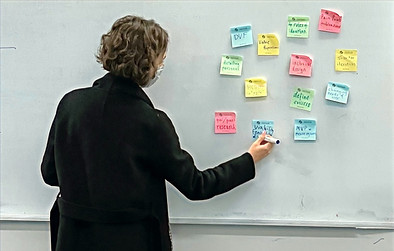experience designer + (they / them)
Polyglot Languages
UX / UI design
"the importance of language is often overlooked... user engagement starts with communication."
Polyglot delivers classes and professional services to students in 3 different languages. In order to communicate with adults from various language backgrounds, clear functional English was paramount.
Research I conducted led to a leaner redesign of the school's products that enhanced accessibility and service delivery.

As a designer, Polyglot has been the ideal sandbox for me to build my own product end-to-end. This is the project that inspired me to get into UX. In late 2020 I discovered design sprints to successfully run my small business and school which has employed two teachers and taught hundreds of students.
Over the past 3 years, I have created all content, curricula, products, web design, social media, based on research and usability testing to improve student experience. It's a constant WIP, as I'm always learning more.
Currently I'm working on building an app in Adobe XD (screenshots above).
As a teacher, I know how essential clear, concise communication is to the learning experience. If an idea isn't properly expressed and its concept received, you may fall short of what you were trying to achieve.
Polyglot delivers professional services to students in 3 languages who live in Australia and overseas and access classes online and face to face through an online booking website.
By surveying and interviewing Polyglot’s student base about their ideal product, I identified the needs of the business through both a case by case study and a broader scope of student opinion.
Check out the survey and interview questions here.
Research found students preferred shorter classes, one to one lessons or small group conversation with the top three key focus areas being pronunciation, grammar and cultural studies.
With usability testing, I redesigned the school's website so that it was more accessible by removing clunky walls of texts, standardising the menu, styles and removing unnecessary links to the rabbit holes of excessive pages.
The biggest change was to the school's products. Polyglot offered a wide range of learning products, a "catch-all" approach to try to cater to as many varied student preferences as possible.
By identifying student needs and creating personas based on their responses, I reduced the confusing amount of lesson options into a simple, more accessible selection that still met student desired outcomes.
As a result, the number of enrolments doubled for the following semester's intake.


ask me about my thoughts on 'plain English'
in design - regarding this NNGroup article

